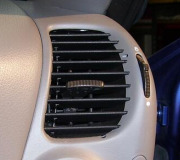Hi,
The problem can be directly related to the climate control panel. However, I would like to confirm that before replacing parts. There are two options on this vehicle. First, you can pull diagnostic trouble codes by simply using a jumper wire at the OBD1 data link connector. Here is a link that shows how it is done.
https://www.2carpros.com/articles/buick-cadillac-chevy-gmc-oldsmobile-pontiac-gm-1983-1995-obd1-code-definitions-and-retrieval-method
Or you can access the self diagnostic mode on the vehicle to indicate codes. Here are the directions for doing that:
_______________________________
1992 Cadillac DeVille V8-300 4.9L
Entering Self-Diagnostic Mode
Vehicle Cruise Control Testing and Inspection Reading and Clearing Diagnostic Trouble Codes Entering Self-Diagnostic Mode
ENTERING SELF-DIAGNOSTIC MODE
In the process of controlling the various subsystems, the ECM and PCM continually monitor operating conditions for possible malfunctions. By comparing system conditions against standard operating limits certain circuits and component malfunctions can be detected. A two digit numerical code is stored in the computer memory when a problem is detected by this self diagnostic system.
If the ECM diagnostics detect a fault, the cruise control system will be inhibited for the entire ignition cycle. The faults that may inhibit the cruise control system are as follows:
1. Fault with vehicle speed sensor or throttle position sensor circuit.
2. Cruise control requested above 90 mph.
3. A rapid rise in RPM's.
4. Difference between vehicle speed and set speed is too high.
5. Transaxle is shifted to neutral position.
6. ECM detects battery voltage either too high or too low.
7. Acceleration is too high.
8. Coolant temperature is too high.
9. On 1991 models, a cruise control servo position sensor is shorted or grounded.
10. The cruise is On, brake is not depressed an the PCM output is HI when it should be LOW, or vice-versa.
11. A throttle angle greater than 20° and the servo position sensor indicates a stroke greater than commanded.
12. Servo position sensor indicates that the servo is still engaged after cruise control has been disengaged.
13. Vehicle speed cycles from 30 mph or greater to 0 mph with no VCC brake switch input, and the PCM will record 10 of these consecutively.
14. Park neutral switch is closed when the vehicle is in 4th gear with speed between 23 and 35 mph for 10 seconds.
Codes other than described may be stored in the control module memory and displayed when the system is accessed to diagnose cruise control malfunctions. It may be necessary to identify and diagnose the failures caused by these additional codes in order to ensure proper system operation.
Intermittent Problem Diagnosis
Trouble codes displayed during the first pass of ECM diagnostic codes, but not the second pass, are considered intermittent. Intermittent trouble codes are those that the ECM previously determined to be faulty but later tested good. If the code is intermittent, most charts will refer to a special note. Do not bypass the charts when checking intermittent conditions. Failure to check an intermittent condition may result in replacement of good components.
Many intermittent problems are caused by poor electrical connections. Diagnosis should start with visual and physical inspection of connectors which are related with the code.
Entering Self-Diagnostic Mode
1. Turn ignition switch on.
2. Simultaneously depress the Off and Warmer buttons on the climate control panel and hold buttons until all display panel segments are illuminated which indicates the beginning of the diagnostic readout. The purpose of illuminating the two display panels is to ensure that all segments are working. If any segments are are inoperative, the affected display panel must be replaced.
3. After the display segment check is completed, any stored trouble code will be displayed on the data center. These two-digit codes will be displayed with a prefix of either E or F to designate which computer sensed the malfunction. If a trouble code is displayed, or if the self-diagnostics system cannot be accessed, a defect has been sensed in the vehicle's electronic control system. To diagnose these malfunctions, refer to the ``Fuel Injection Section'' in the MOTOR's Auto Engine Tune Up & Electronics manual.
4. After all codes are displayed or if no trouble codes are stored, the code .7.0 will appear on the display.
Code .7.0
Code .7.0 is a decision point. When this code is displayed, the diagnostic feature relevant to the current malfunction can be selected. The two diagnostic modes relevant to cruise control diagnosis, ECM switch tests and ECM output cycling, are detailed below.
Clearing Trouble Codes
The trouble codes stored in the system memory can be cleared to aid in diagnosing intermittent conditions. To clear codes, proceed as follows:
1. Enter diagnostic mode as outlined.
2. To clear engine control module (ECM) codes, simultaneously depress the Off and HI buttons on the climate control panel and hold the buttons until the code E.0.0 is displayed.
3. To clear body control module (BCM) codes, simultaneously depress the Off and LO buttons on the climate control panel and hold until the code F.0.0 is displayed.
4. After E.0.0 and F.0.0 are displayed, the code .7.0 will be displayed. With this code displayed, turn off ignition and leave ignition off for at least 10 seconds before re-entering the diagnostic mode.
Exiting Self-Diagnostic Mode
To exit the self-diagnostic mode, depress the AUTO button on the climate control panel or turn of ignition for at least 10 seconds.
______________________________________
Once you find the codes, I will be able to better direct you to the source of the issue. Let me know what codes are found. If you need help or have other questions, let me know.
Take care,
Joe
Monday, April 27th, 2020 AT 8:00 PM



